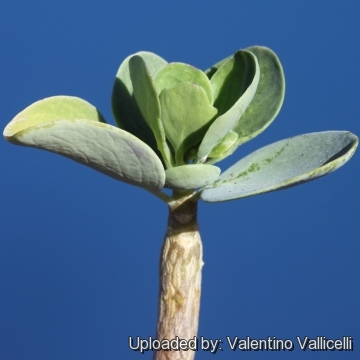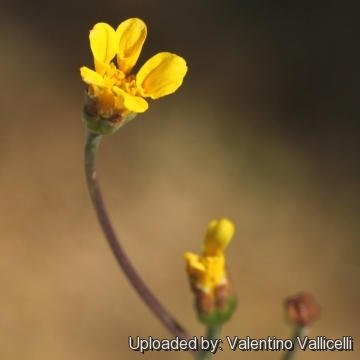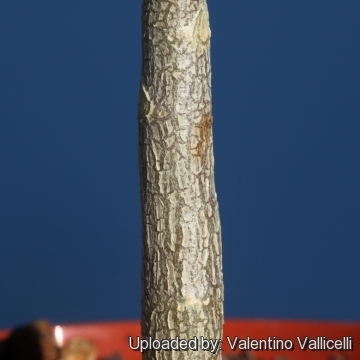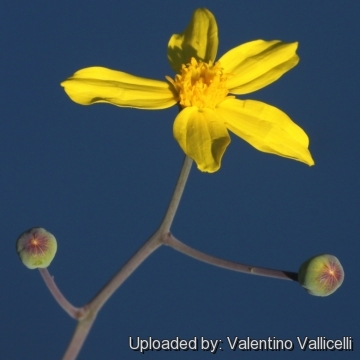
Othonna triplinervia Photo by: Valentino Vallicelli
Origin and Habitat: South Africa, Eastern Cape.
Altitude: It grows at an altitude of more or less 400-800 m.
Habitat: It grows in crevices and on ledges of sheer, east-facing aspects on mineral-poor quartzitic sandstone soil. Rainfall occurs during both winter (cold fronts) and summer (mainly thunder showers) and amounts to about 500–600 mm per annum. The average daily maximum temperature is about 26°C and the average daily minimum temperature is about 11°C. Winters are cooler but frost is rare or absent.
It shares its habitat with other cliff-dwelling plants such as Haworthia gracilisSN|21283]]SN|15017]] var. picturata, Haworthia viscosaSN|15017]]SN|21283]], Cyrtanthus montanus, Plectranthus verticillatus, Gasteria glauca, Crassula lacteaSN|26720]]SN|26720]] and Lampranthus affinis. The plant has been well established in cultivation (ex situ conservation) and is grown by succulent plant growers all over the world.
Synonyms:
Common Names include:
ENGLISH: Baboon's Cabbage Bush, Thicket baboon's cabbage
AFRIKAANS (Afrikaans): Bobbejaankoolbosse, Ruigte-bobbejaankool
Description: It is a a thick, evergreen, fleshy-stemmed (pachycaul) shrublets with short branches and leaves crowded at the tips.
Stem (caudex): Shrubby carnose swollen at the base, glabrous, short, subsimple or forked up to 4 cm thick (or more) and 40 cm tall, the lower part nude (leafless), cicatricised; cicatrices glabrous.
Leaves: Crowded toward the apices, 6-7 cm long (comprising petiole), 2,5 cm wide, obovate, obtuse, tapering at base into a slender petiole, drying thin, from the middle 3-nerved, netted-veined, quite entire or repand; slightly fleshy when young, almost membranous, and pellucid if carefully dried.
Inflorescence: Terminal, loosely corymbose, few or several headed, peduncle somewhat longer than the leaves.
Flowers: Rays about 5 bright-yellow, conspicuous. Pedicels 7-10 cm long
Fruit: Villous achenes.
Bibliography: Flora Capensis, Vol 3, page 44 (1894) Author: (By W. H. HARVEY).
 Othonna triplinervia Photo by: Valentino Vallicelli
Othonna triplinervia Photo by: Valentino Vallicelli Othonna triplinervia Photo by: Valentino Vallicelli
Othonna triplinervia Photo by: Valentino Vallicelli Othonna triplinervia Photo by: Valentino Vallicelli
Othonna triplinervia Photo by: Valentino Vallicelli Othonna triplinervia Photo by: Valentino Vallicelli
Othonna triplinervia Photo by: Valentino Vallicelli Othonna triplinervia Photo by: Valentino Vallicelli
Othonna triplinervia Photo by: Valentino VallicelliSend a photo of this plant.The gallery now contains thousands of pictures, however it is possible to do even more. We are, of course, seeking photos of species not yet shown in the gallery but not only that, we are also looking for better pictures than those already present.
Read More... Cultivation and Propagation: Othonna triplinerviaSN|23336]]SN|23336]] is probably a winter grower and need water from October, when the new leaves can be seen forming on the growing tip. In April the leaves begin to go yellow and drop off, so now it rests quite dry in to summer. But others suggest to water it moderately all year round as it tends to be an evergreen if water is available. They must be grown very hard in the nursery as close to the natural conditions as possible. This ensures that they keep their compact habit.















